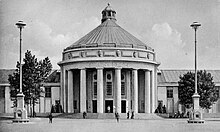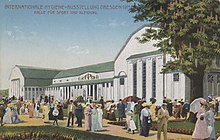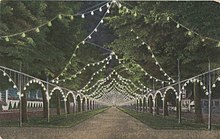International Hygiene Exhibition Dresden 1911


The International Hygiene Exhibition 1911 in Dresden was created from the idea and largely at the instigation of the successful Odol -Fabrikanten Karl August Lingner . With 5.2 million visitors, it was the most popular exhibition in Dresden to date. It ran from May 6 to October 31, 1911.
Concern of the exhibition
Dresden was able to fall back on extensive exhibition experience within the planning of this event. A specially designed area with the City Exhibition Palace has been available since 1896 . The city had already seen seven international and other national exhibitions since 1887. The resulting experiences among the citizens and the public administration eased the matter immensely.
Karl August Lingner had been able to carefully study the knowledge and reactions among people since 1892 when developing and selling hygiene articles. At the end of the 19th and beginning of the 20th centuries, large parts of the population had only a few and often unstructured ideas about this topic. That was, among other things. a cause of some worrying developments in urban agglomerations. The increase in tuberculosis , skin and sexually transmitted diseases as well as insufficiently prepared food created enormous pressure to act, which led to various decisions by public and private officials. For example, the disinfection system and the construction of large central cattle slaughterhouses experienced a considerable development boost.
The intended objective of "... to undertake a briefing of the general public about health care once on a large scale" was more than fulfilled. The success encouraged later similar projects in Düsseldorf ( GeSoLei 1926 ) and Dresden ( 1930/31 ). The interactions with the reform movements and urban planning are noteworthy. The emergence of the light-oriented settlements interspersed with green zones found their exclusive expression in the deliberately designed garden cities, but took up more global space in the later Bauhaus movement. Already in the preparatory phase, Lingner thought about creating a hygiene museum in order to be able to provide a permanent information impulse. The uncertain long-term financing made him refrain from doing so.
Preparations
In preparation, the Association for the Organization of the International Hygiene Exhibition in 1911 was founded in 1908 . The central person for this project was Karl August Lingner. He was elected director of the exhibition project on February 12, 1910 at a workshop in the auditorium of the Technical University . Representatives from eleven countries had come to this conference and in this way documented the international interest in the exhibition.
Preparations included a poster competition in 1910, which saw widespread participation. The jury was dissatisfied with the evaluation of many of the submitted works. A first prize was not awarded. Finally, the design of the young, then insignificant glass painter and later poster artist Willi Petzold was taken up with the eye motif. Lingner commissioned the Munich artist Franz von Stuck to convert this motif into a poster. The jury consisted of Carl Bantzer (Dresden), Paul Schumann (Dresden), Otto Gussmann (Dresden), Karl August Lingner (Dresden), Max Seliger (Leipzig) and Georg Wrba (Dresden). 530 works were submitted for the competition.
The exhibition concept, which has already been shown successfully in Dresden for several decades, consisted of a thematically coherent combination of popularly prepared scientific knowledge, visually / didactically well-positioned presentations, the presentation of successful and new products from regional and foreign exhibitors, consistently thought-out integration of art objects and an area for entertainment and catering. Furthermore, attention was paid to a coherent inner-city transport connection and national rail connections.
Outline and buildings
The exhibition took up an area beyond the area of the Municipal Exhibition Palace and thus included parts of the Great Garden and Güntzwiesen . The total exhibition area was 320,000 square meters.
The main areas of the International Hygiene Exhibition were:
- Historical-ethnographic department
- Infectious diseases
- Tropical diseases
- German workers' insurance
- Chemistry, scientific instruments, cosmetics
- Baths and health resorts, mineral waters
- Children and adolescents
- Profession and work, technology and machines
- Settlement and housing
- Clothing and personal care, games and sports
- Food and beverage
- Hygiene in traffic
- Health care and rescue services
- Army, Navy and Colonial Hygiene
- commercial individual exhibitors
- Popular Department (Man)
- Foreign departments (Brazil, China, England, France, Italy, Japan, Austria, Russia, Switzerland, Spain, Hungary). Not all participating states financed a single exhibition area, but took part in thematic complexes.
The architects Lossow and Kühne were responsible for the general structural design . Other architects took part in subtasks, including Martin Dülfer , Georg Heinsius von Mayenburg and Hermann Viehweger .
The exhibition palace (sometimes called the stone palace) formed the architectural focal point. Several smaller individual buildings were grouped around it. Due to traffic issues and the expected storm of visitors, the entrance area was not directed via the main portal of the exhibition palace. For this purpose, a representative portico was built on Lennéstrasse . The entrance situation led straight to the “Der Mensch” hall, a clever solution to emphasize the central concern as soon as you enter the exhibition.
Particularly noteworthy buildings are some of the foreign "representations". The Russian, Japanese and Chinese state pavilions particularly caught the eye. Furthermore, the buildings stood out from the entertainment sector because of their originality. In the place of today's Dynamo stadium , the existing sports field was integrated into the exhibition. Here was the bronze sculpture of the athlete throwing the ball, which later found its place in front of the German Hygiene Museum .
There were two bridges to connect the exhibition areas on both sides of Lennéstrasse. In the immediate vicinity there was a building with a tower. It housed the power plant specially built for the exhibition. Because of the extensive energy requirements, the decision was made to generate it independently. The core of the tower consisted of the unavoidable chimney.
Selected thematic aspects
The thematic breadth within the International Hygiene Exhibition was very large. That is why the show took up a space that extended beyond the actual municipal exhibition grounds.
Foreign departments
The nations represented with their own department presented the visitors in the respective state pavilions mainly the progress of their national health system, typical forms of nutrition and living, educational work and relevant national history. England also placed selected results from tropical medicine as well as bacteriological and carcinological research in the foreground as part of its national and colonial activities. Russia presented itself in great breadth. Notable topics were climatological research results (Caucasus, Black Sea coast), mineral water resources ( Borjomi mineral water received an honorary diploma in Dresden), drinking water treatment and the fight against alcoholism .
job and work
The special occupational statistics and occupational hygiene subdivision dealt with the statistical determination of occupational diseases and possible preventive measures. Italy stood out with the presentation of a clinic for workers' diseases in Milan and its collection of regulations on occupational safety . Numerous examples demonstrated the improvement of light and air supply as well as the avoidance of dust at the workplace and an example from industrial weaving demonstrated efforts to ergonomically design the work area on machines.
Infectious diseases
This area was designed in two subdivisions by well-known physicians from Berlin, Dresden and Munich. One part was devoted to questions of immunity and vaccination and the other to general disease control ( disinfection ). The topics exhibited here had been prepared by international scientists. In addition to German doctors and public officials, representatives from Belgium, Mexico and Sweden took part. The neighboring Tropical Diseases Department naturally had an even stronger international participation.
A separate pavilion was dedicated to venereal diseases , for which the Dresden dermatologist Eugen Galewsky was conceptually responsible. For this purpose, it was already possible to fall back on Johannes Werther's moulage collection , whose realistic depiction brought the pavilion on the one hand enormous popularity, but on the other hand also dubbed “Galewsky's Chamber of Horrors”.
Municipal duties
In the area of German cities, the focus was on the presentation of the latest developments in the areas of city cleaning, water supply, urban development / housing (planning / structure / upgrading) and municipal statistics.
Financial structure
To finance the huge exhibition project, the exhibition management focused on the income from the company. In the closing balance, a revenue item of 6,665,536.30 marks was shown. The largest sources of income lay in the entrance fees (2.35 million marks) and space rents from exhibitors (2.30 million marks). The city grant amounted to 200,000 marks. The main focus of the expenditure was the cost of building and interior work with 2.35 million marks. Advertising expenses comprised a total of around 519,000 marks. The exhibition closed with a positive result of just over a million marks. This net profit benefited the foundation for the establishment of a national hygiene museum .
The final invoice does not include the sometimes considerable expenditure by foreign countries and all private exhibitors.
Results
With the International Hygiene Exhibition, at a time of widespread chronic and epidemic diseases, there was a surge in sensitivity to questions of purity, medical and everyday preventive measures and health maintenance. The organizers of the exhibition took up the interest in sport among the population in a striking way. This gave the already existing movements, which dealt with the creation of a balanced lifestyle and a sport-oriented leisure activity (hiking, gymnastics), great ideal support. The stimulating contribution to developments in modern urban planning can hardly be grasped due to its diverse effects. Dresden itself had been able to establish itself as the city of health education in an international context for several decades and set an original point of content for its self-image.
Due to the ingenious idea of the selected exhibition poster, the “watchful eye” as a symbol for hygiene issues has repeatedly been used and artistically taken up. It has a special position within the framework of modern symbolism.
Lingner was able to realistically consolidate the basis for the hygiene museum he had devised with the remaining exhibition objects and the established connections to specialists and specialist institutions. His relatively early death in 1916 prevented further important impulses from this visionary and wealthy entrepreneur.
The demanding activities for health education by the German Hygiene Museum, which emerged from this story, continue unabated to this day. Lingner's guiding principle, "Hygiene is the doctrine of maintaining and caring for human health, the doctrine of maintaining human well-being", has repeatedly found contemporary answers.
The Undosa wave machine shown at the exhibition was bought by the naturopath Eduard Bilz and installed in his light-air bath . It is probably the oldest functioning wave machine, despite its status as a technical monument, in daily outdoor pool operation in Radebeul's Bilzbad .
miscellaneous
At the same time, women's rights activist and sex reformer Helene Stöcker organized the first international congress for maternity protection and sexual reform in Dresden.
Other important exhibitions on the same subject were the GeSoLei (Düsseldorf 1926) and the International Hygiene Exhibition Dresden 1930 , which at least in part built on the experience of the 1911 exhibition.
In 1986 a special exhibition entitled 75 Years of the I. International Hygiene Exhibition Dresden 1911 was shown in the German Hygiene Museum .
swell
- Official guide through the International Hygiene Exhibition Dresden 1911 and through Dresden and the surrounding area . Berlin (Rudolf Mosse) [1911]
- Official catalog of the International Hygiene Exhibition . Dresden May to October 1911. Berlin (Rudolf Mosse) 1911
- Salonblatt 1910, No. 8, 23
- Journal of Local Economy and Local Policy 1911, No. 19/20
- Klaus Vogel / Christoph Wingender: "... which is therefore worth a visit under all circumstances" The I. International Hygiene Exhibition 1911. In: Dresdner Hefte, No. 63, Large exhibitions around 1900 and in the twenties. Dresden 2000, pp. 44-52
Web links
Individual evidence
- ^ Official guide through the International Hygiene Exhibition Dresden 1911 and through Dresden and the surrounding area. Berlin (Rudolf Mosse) [1911], p. 13
- ↑ Hildegard Walther: pioneering deeds of a poster artist . Sächsisches Tageblatt, February 24, 1974
- ^ Albrecht Scholz: Jewish Doctors in Dresden in the 20th Century . In: Dresdner Geschichtsverein (Ed.): Between Integration and Destruction - Jewish Life in Dresden in the 19th and 20th Centuries (= Dresdner Hefte - Contributions to Cultural History. No. 45, 2nd, revised edition, June 2000). Dresden 2000, ISBN 3-910055-34-6 ., Here pp. 65–66.
- ↑ Irene Meichsner: For cleanliness and health. In: Calendar sheet (broadcast on DLF ). May 6, 2011, accessed May 6, 2011 .
- ^ Official guide through the International Hygiene Exhibition Dresden 1911 and through Dresden and the surrounding area. Berlin (Rudolf Mosse) [1911], p. 9
- ↑ H. Stöcker (2015): Lebenserinnerungen, ed. by Reinhold Lütgemeier-Davin and Kerstin Wolff. Cologne 2015, pp. 153–156.






